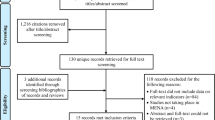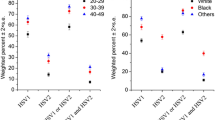Abstract
Objectives
To assess whether herpes simplex virus type 2 (HSV-2) infection has an effect on the risk of cervical cancer.
Methods
A systematic literature search of PubMed, Embase, Web of Science, and Scopus from their inception through July 2013 was conducted and reference lists of retrieved articles were reviewed. Information on the characteristics of the included studies, risk estimates, and control for possible confounding factors was extracted independently by two investigators. A random effects model was used to calculate the pooled risk estimates.
Main results
Sixteen articles with 20 studies (14 case control and 6 longitudinal) involving 3,337 patients with cervical cancer were included. Compared with individuals who did not experience HSV-2 infection, the pooled ORs of cervical cancer for individuals with HSV-2 infection were 1.37 (95 % CI 1.12–1.69) for traditional case–control studies and 1.04 (95 % CI 0.82–1.31) for prospective or retrospective nested case–control studies.
Conclusions
Given that a longitudinal study gives a higher level of evidence than a traditional case–control study, the existing observational epidemiological evidence do not support a harmful effect of HSV-2 infection on cervical cancer.



Similar content being viewed by others
References
Arbyn M, Castellsagué X, De Sanjosé S, Bruni L, Saraiya M, Bray F, Ferlay J (2011) Worldwide burden of cervical cancer in 2008. Ann Oncol 22(12):2675–2686
Vesco KK, Whitlock EP, Eder M, Burda BU, Senger CA, Lutz K (2011) Risk factors and other epidemiologic considerations for cervical cancer screening: a narrative review for the US Preventive Services Task Force. Ann Intern Med 155(10):698
Rawls W, Tompkins W, Figueroa M, Melnick J (1968) Herpesvirus type 2: association with carcinoma of the cervix. Science (New York, NY) 161(847):1255
Hausen H (1982) Human genital cancer: synergism between two virus infections or synergism between a virus infection and initiating events? Lancet 320(8312):1370–1372
Vonka V, Kanka J, Hirsch I, Zavadova H, Krcmar M, Suchankova A, Rezacova D, Broucek J, Press M, Domorazkova E et al (1984) Prospective study on the relationship between cervical neoplasia and herpes simplex type-2 virus. II. Herpes simplex type-2 antibody presence in sera taken at enrollment. Int J Cancer 33(1):61–66
Lehtinen M, Koskela P, Jellum E, Bloigu A, Anttila T, Hallmans G, Luukkaala T, Thoresen S, Youngman L, Dillner J, Hakama M (2002) Herpes simplex virus and risk of cervical cancer: a longitudinal, nested case-control study in the nordic countries. Am J Epidemiol 156(8):687–692
Stroup DF, Berlin JA, Morton SC, Olkin I, Williamson GD, Rennie D, Moher D, Becker BJ, Sipe TA, Thacker SB (2000) Meta-analysis of observational studies in epidemiology: a proposal for reporting. Meta-analysis Of Observational Studies in Epidemiology (MOOSE) group. JAMA 283(15):2008–2012
DerSimonian R, Laird N (1986) Meta-analysis in clinical trials. Control Clin Trials 7(3):177–188. doi:10.1016/0197-2456(86)90046-2
Higgins JP, Thompson SG, Deeks JJ, Altman DG (2003) Measuring inconsistency in meta-analyses. BMJ (Clinical research ed) 327(7414):557–560. doi:10.1136/bmj.327.7414.557327/7414/557
Begg CB, Mazumdar M (1994) Operating characteristics of a rank correlation test for publication bias. Biometrics 50(4):1088–1101
Peters JL, Sutton AJ, Jones DR, Abrams KR, Rushton L (2006) Comparison of two methods to detect publication bias in meta-analysis. JAMA 295(6):676–680. doi:10.1001/jama.295.6.676
Arnheim Dahlstrom L, Andersson K, Luostarinen T, Thoresen S, Ogmundsdottir H, Tryggvadottir L, Wiklund F, Skare GB, Eklund C, Sjolin K, Jellum E, Koskela P, Wadell G, Lehtinen M, Dillner J (2011) Prospective seroepidemiologic study of human papillomavirus and other risk factors in cervical cancer. Cancer Epidemiol Biomark Prev 20(12):2541–2550. doi:10.1158/1055-9965.epi-11-0761
Chaouki N, Bosch FX, Muñoz N, Meijer CJ, El Gueddari B, El Ghazi A, Deacon J, Castellsagué X, Walboomers JM (1998) The viral origin of cervical cancer in Rabat, Morocco. Int J Cancer 75(4):546–554
Chichareon S, Herrero R, Muñoz N, Bosch FX, Jacobs MV, Deacon J, Santamaria M, Chongsuvivatwong V, Meijer CJ, Walboomers JM (1998) Risk factors for cervical cancer in Thailand: a case-control study. J Natl Cancer Inst 90(1):50–57
Choi NW, Shettigara PT, Abu-Zeid HA, Nelson NA (1977) Herpesvirus infection and cervical anaplasia: a seroepidemiological study. Int J Cancer 19(2):167–171
Eluf-Neto J, Booth M, Muñoz N, Bosch F, Meijer C, Walboomers J (1994) Human papillomavirus and invasive cervical cancer in Brazil. Br J Cancer 69(1):114
Ferrera A, Baay MF, Herbrink P, Figueroa M, Velema JP, Melchers WJ (1997) A sero-epidemiological study of the relationship between sexually transmitted agents and cervical cancer in Honduras. Int J Cancer 73(6):781–785
Lehtinen M, Hakama M, Aaran RK, Aromaa A, Knekt P, Leinikki P, Maatela J, Peto R, Teppo L (1992) Herpes simplex virus type 2 infection and cervical cancer: a prospective study of 12 years of follow-up in Finland. Cancer Causes Control 3(4):333–338
Lehtinen M, Dillner J, Knekt P, Luostarinen T, Aromaa A, Kirnbauer R, Koskela P, Paavonen J, Peto R, Schiller JT, Hakama M (1996) Serologically diagnosed infection with human papillomavirus type 16 and risk for subsequent development of cervical carcinoma: nested case-control study. BMJ (Clinical research ed) 312(7030):537–539
Muñoz N, Bosch F, De Sanjosé S, Tafur L, Izarzugaza I, Gili M, Viladiu P, Navarro C, Martos C, Ascunce N (1992) The causal link between human papillomavirus and invasive cervical cancer: a population-based case–control study in colombia and Spain. Int J Cancer 52(5):743–749
Munoz N, Kato I, Bosch FX, De Sanjose S, Sundquist VA, Izarzugaza I, Gonzalez LC, Tafur L, Gili M, Viladiu P et al (1995) Cervical cancer and herpes simplex virus type 2: case-control studies in Spain and Colombia, with special reference to immunoglobulin-G sub-classes. Int J Cancer 60(4):438–442
Ngelange C, Muñoz N, Bosch FX, Festin MR, Deacon J, Jacobs MV, Santamaria M, Meijer CJ, Walboomers JM (1998) Causes of cervical cancer in the Philippines: a case–control study. J Natl Cancer Inst 90(1):43–49
Peng HQ, Liu SL, Mann V, Rohan T, Rawls W (1991) Human papillomavirus types 16 and 33, herpes simplex virus type 2 and other risk factors for cervical cancer in Sichuan Province, China. Int J Cancer 47(5):711–716
Perez LO, Barbisan G, Abba MC, Laguens RM, Dulout FN, Golijow CD (2006) Herpes simplex virus and human papillomavirus infection in cervical disease in Argentine women. Int J Gynecol Pathol 25(1):42–47
Santos C, Munoz N, Klug S, Almonte M, Guerrero I, Alvarez M, Velarde C, Galdos O, Castillo M, Walboomers J (2001) HPV types and cofactors causing cervical cancer in Peru. Br J Cancer 85(7):966
Vonka V, Kanka J, Jelinek J, Subrt I, Suchanek A, Havrankova A, Vachal M, Hirsch I, Domorazkova E, Zavadova H et al (1984) Prospective study on the relationship between cervical neoplasia and herpes simplex type-2 virus. I. Epidemiological characteristics. Int J Cancer 33(1):49–60
Lehtinen M, Hakama M, Knekt P, Heinonen PK, Lehtinen T, Paavonen J, Teppo L, Leinikki P (1989) Lack of serum antibodies to the major HSV-2 specified DNA-binding protein before diagnosis of cervical neoplasia. J Med Virol 27(2):131–136
Conflict of interest
We declare we have no conflict of interest. No funding received for this systematic review.
Author information
Authors and Affiliations
Corresponding author
Rights and permissions
About this article
Cite this article
Cao, S., Gan, Y., Dong, X. et al. Herpes simplex virus type 2 and the risk of cervical cancer: a meta-analysis of observational studies. Arch Gynecol Obstet 290, 1059–1066 (2014). https://doi.org/10.1007/s00404-014-3365-7
Received:
Accepted:
Published:
Issue Date:
DOI: https://doi.org/10.1007/s00404-014-3365-7




